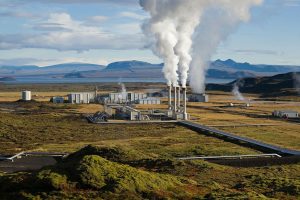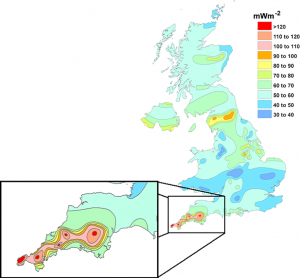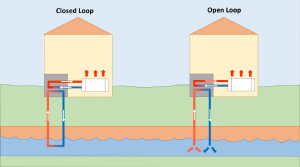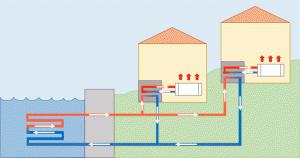Advantages of Geothermal Energy
Deep Geothermal Energy (HSA & EGS)
The Basics

Geothermal energy is energy in the form of heat (thermal) stored beneath the earth’s surface (geo). It has been used as a source of heat for as long as people have been around to take advantage of it. Hot springs and geysers are formed when natural ground water heated by geothermal energy finds its way to the surface. Different technologies can utilise this energy to create heat for homes and offices, or to generate electricity.
Advantages of Geothermal Energy
- Carbon free, renewable and sustainable form of energy
- Unlike many other sources of renewable energy, it is not affected by the weather; it is available 24 hours a day, 7 days a week
- The surface area required for the power plant is the smallest of all power sources (nuclear, coal, solar etc), so it has low impact on the landscape
Deep Geothermal Energy

Large scale geothermal energy plants are normally located in regions of volcanic activity, such as Iceland and New Zealand.
These regions have access to very high temperature steam/water that allow the use of ‘direct dry’ and ‘flash’ steam turbines to produce electricity.
Although the UK is not actively volcanic, there is still a substantial resource of geothermal energy in other forms:
- Hot Sedimentary Aquifer (HSA) systems – the heat energy is stored in large natural reservoirs underground, called aquifers.
- Engineered Geothermal Systems (EGS) – the heat energy is stored in rocks, which require stimulation to engineer a reservoir. This involves the injection of water into the rocks to extract the heat. Either exploiting natural permeability/fractures in the rock, or the permeability can be improved by injecting at high pressure.
Geothermal in Cornwall

Cornwall has limited viability for HSA due to the granite geology, which lacks natural circulating water. However the Cornish granite does offer a source of radiogenic heat which makes it an ideal location for EGS. The Cornubian Batholith (granite) extends over an area of approximately 2,500 km2 and is characterised by the highest heat flow values in the UK. Typical background heat flow of the UK is approximately 52mW/m2, whilst in Cornwall the heat flow is approximately 110 mW/m2.
By simultaneously injecting and extracting water from the natural fracture structures in the granite, it is possible to create the necessary conditions to extract the heat, which can then be used for direct heating of homes, or to produce electricity in a ‘binary’ power plant.
THE UNITED DOWNS DEEP GEOTHERMAL POWER PROJECT IS AIMING TO DO JUST THAT
Ground Source Heat Pumps (GSHP)
There is also another source of heat at shallower depth, suitable for domestic scale use. At depths of ~15m and greater the ground temperature (heated by the sun) is not influenced by seasonal air temperatures, and so remains stable at approximately 9-13°C all year round.
This heat can be exploited by a ground source heat pump (GSHP), which extracts it from the ground via heat exchangers, either in vertical boreholes or shallow horizontal trenches. With the use of a small amount of electricity it can then raise the temperature to a level suitable for domestic heating (typically 40-70°C). Current GSHP technology can produce up to 5 kW of heat for every 1 kW of electricity used, and can completely replace a traditional boiler.
Financial Incentives:
The Renewable Heat Incentive (RHI) is a UK Government scheme to encourage uptake of renewable heat technologies. People who install GSHP’s and join the scheme can receive quarterly payments for seven years based on the amount of clean, renewable heat their system produces.
INTERESTED IN A GROUND SOURCE HEAT PUMP? LEARN MORE
Mine Water as a Heat Resource

Another potential source of energy that can be utilised by heat pumps is that of the heat stored in abandoned mines. Mines that are now flooded contain large volumes of water at 12-25℃ (depending on depth), which heat pumps can boost to temperatures suitable for hot water and space heating.
The mine water can be abstracted by a borehole drilled into the flooded workings, the heat is removed and boosted by a heat pump, before the water is returned to the mine via a second borehole. This is called an ‘open-loop’ GSHP system, unlike traditional ‘closed-loop’ GSHP systems where the working fluid remains contained within the borehole/ground loop. The benefit of open loop is that it offers better thermal efficiency than standard closed-loop systems.
Mine-water systems such as this can be used for district heating, or with a central energy centre, meaning that clusters of hundreds of properties could be served from a single mine and a few boreholes.
Sea Water as a Heat Resource

In the same way that mine water can be used as a heat resource, sea water also offers similar benefits. In Cornwall the sea ranges from around 10-18 degrees through out the year, which heat pumps can utilise to provide heating for homes and business.
Due to the salinity of sea water (high salt content) which can damage open loop heat exchangers, these systems are usually operated with a closed loop heat exchanger fixed to the sea bed.

